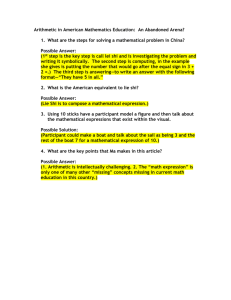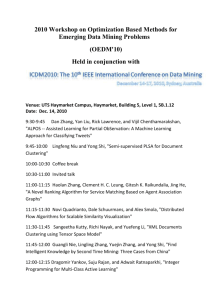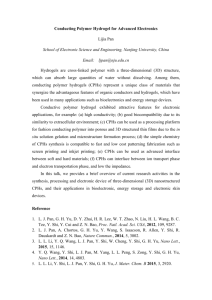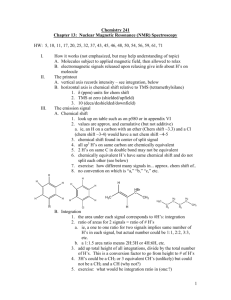Myers_MethodPreparation
advertisement
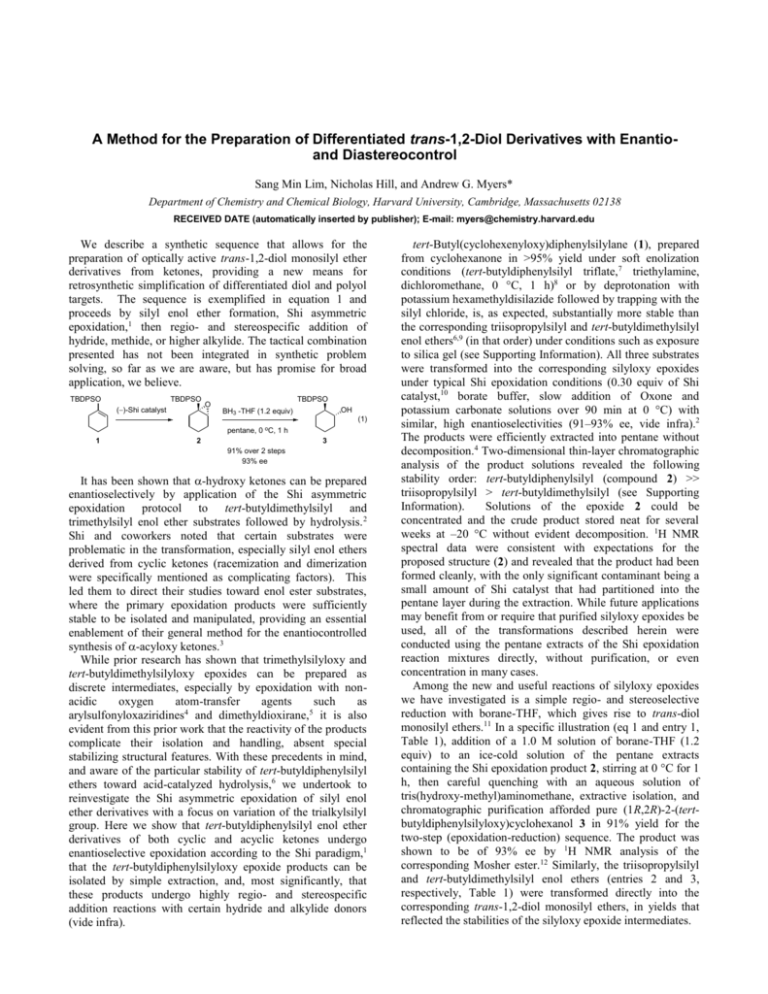
A Method for the Preparation of Differentiated trans-1,2-Diol Derivatives with Enantioand Diastereocontrol Sang Min Lim, Nicholas Hill, and Andrew G. Myers* Department of Chemistry and Chemical Biology, Harvard University, Cambridge, Massachusetts 02138 RECEIVED DATE (automatically inserted by publisher); E-mail: myers@chemistry.harvard.edu We describe a synthetic sequence that allows for the preparation of optically active trans-1,2-diol monosilyl ether derivatives from ketones, providing a new means for retrosynthetic simplification of differentiated diol and polyol targets. The sequence is exemplified in equation 1 and proceeds by silyl enol ether formation, Shi asymmetric epoxidation,1 then regio- and stereospecific addition of hydride, methide, or higher alkylide. The tactical combination presented has not been integrated in synthetic problem solving, so far as we are aware, but has promise for broad application, we believe. TBDPSO TBDPSO ()-Shi catalyst O TBDPSO pentane, 0 1 OH BH3 -THF (1.2 equiv) oC, (1) 1h 2 3 91% over 2 steps 93% ee It has been shown that -hydroxy ketones can be prepared enantioselectively by application of the Shi asymmetric epoxidation protocol to tert-butyldimethylsilyl and trimethylsilyl enol ether substrates followed by hydrolysis. 2 Shi and coworkers noted that certain substrates were problematic in the transformation, especially silyl enol ethers derived from cyclic ketones (racemization and dimerization were specifically mentioned as complicating factors). This led them to direct their studies toward enol ester substrates, where the primary epoxidation products were sufficiently stable to be isolated and manipulated, providing an essential enablement of their general method for the enantiocontrolled synthesis of -acyloxy ketones.3 While prior research has shown that trimethylsilyloxy and tert-butyldimethylsilyloxy epoxides can be prepared as discrete intermediates, especially by epoxidation with nonacidic oxygen atom-transfer agents such as arylsulfonyloxaziridines4 and dimethyldioxirane,5 it is also evident from this prior work that the reactivity of the products complicate their isolation and handling, absent special stabilizing structural features. With these precedents in mind, and aware of the particular stability of tert-butyldiphenylsilyl ethers toward acid-catalyzed hydrolysis,6 we undertook to reinvestigate the Shi asymmetric epoxidation of silyl enol ether derivatives with a focus on variation of the trialkylsilyl group. Here we show that tert-butyldiphenylsilyl enol ether derivatives of both cyclic and acyclic ketones undergo enantioselective epoxidation according to the Shi paradigm,1 that the tert-butyldiphenylsilyloxy epoxide products can be isolated by simple extraction, and, most significantly, that these products undergo highly regio- and stereospecific addition reactions with certain hydride and alkylide donors (vide infra). tert-Butyl(cyclohexenyloxy)diphenylsilylane (1), prepared from cyclohexanone in >95% yield under soft enolization conditions (tert-butyldiphenylsilyl triflate,7 triethylamine, dichloromethane, 0 °C, 1 h)8 or by deprotonation with potassium hexamethyldisilazide followed by trapping with the silyl chloride, is, as expected, substantially more stable than the corresponding triisopropylsilyl and tert-butyldimethylsilyl enol ethers6,9 (in that order) under conditions such as exposure to silica gel (see Supporting Information). All three substrates were transformed into the corresponding silyloxy epoxides under typical Shi epoxidation conditions (0.30 equiv of Shi catalyst,10 borate buffer, slow addition of Oxone and potassium carbonate solutions over 90 min at 0 °C) with similar, high enantioselectivities (91–93% ee, vide infra).2 The products were efficiently extracted into pentane without decomposition.4 Two-dimensional thin-layer chromatographic analysis of the product solutions revealed the following stability order: tert-butyldiphenylsilyl (compound 2) >> triisopropylsilyl > tert-butyldimethylsilyl (see Supporting Information). Solutions of the epoxide 2 could be concentrated and the crude product stored neat for several weeks at –20 °C without evident decomposition. 1H NMR spectral data were consistent with expectations for the proposed structure (2) and revealed that the product had been formed cleanly, with the only significant contaminant being a small amount of Shi catalyst that had partitioned into the pentane layer during the extraction. While future applications may benefit from or require that purified silyloxy epoxides be used, all of the transformations described herein were conducted using the pentane extracts of the Shi epoxidation reaction mixtures directly, without purification, or even concentration in many cases. Among the new and useful reactions of silyloxy epoxides we have investigated is a simple regio- and stereoselective reduction with borane-THF, which gives rise to trans-diol monosilyl ethers.11 In a specific illustration (eq 1 and entry 1, Table 1), addition of a 1.0 M solution of borane-THF (1.2 equiv) to an ice-cold solution of the pentane extracts containing the Shi epoxidation product 2, stirring at 0 °C for 1 h, then careful quenching with an aqueous solution of tris(hydroxy-methyl)aminomethane, extractive isolation, and chromatographic purification afforded pure (1R,2R)-2-(tertbutyldiphenylsilyloxy)cyclohexanol 3 in 91% yield for the two-step (epoxidation-reduction) sequence. The product was shown to be of 93% ee by 1H NMR analysis of the corresponding Mosher ester.12 Similarly, the triisopropylsilyl and tert-butyldimethylsilyl enol ethers (entries 2 and 3, respectively, Table 1) were transformed directly into the corresponding trans-1,2-diol monosilyl ethers, in yields that reflected the stabilities of the silyloxy epoxide intermediates. Table 1. Cyclic trans-1,2-Diol Monosilyl Ether Derivatives Formed by Shi Asymmetric Epoxidationa of Silyl Enol Ethers followed by Stereospecific Reduction with Borane-THF Entry Substrate TBDPSO Yieldb eec OH 91 93 OH 82 91 OH 68 91 92 89 82 88 Product TBDPSO 1 TIPSO TIPSO 2 TBSO TBSO 3 TBDPSO TBDPSO OH 4 TBDPSO TBDPSO OH 5 values presented there provide an accurate assessment of the enantioselectivities of the epoxidation step, which are typically above 90%, in keeping with Shi's prior observations.1 The stereochemistry of hydride addition supports a mechanism involving prior coordination of borane to the epoxide oxygen atom followed by epoxide opening and internal hydride transfer, as has been proposed for reductions of glycal epoxide-like substrates with borane-THF,15 although the trajectories for hydride addition are presumably quite different.16 In further evaluating the scope of the epoxidation-reduction sequence we explored acyclic tert-butyldiphenylsilyl enol ethers as substrates and in this context gained mechanistic insight into the reduction process. Asymmetric epoxidationreduction of trans-1-tert-butyldiphenylsilyloxypropene17 afforded (R)-1-(tert-butyldimethylsilyloxy)propan-2-ol in 90% yield and 82% ee (eq 2). Employing BD3-THF in lieu of BH3-THF we found that the reduction proceeded with >95% stereospecificity (eq 3),18 as observed in the cyclic substrate series (Table 1). Epoxidation-reduction (also with BD3-THF) of cis-1-tert-butyl-diphenylsilyloxypropene,19 however, proceeded with substantially diminished stereospecificity (~33%, eq 4), which we rationalize in Figure 1.20 H OTBDPS CH3 TBDPSO TBDPSO OH O O TBDPSO TBDPSO 95 90 82% ee H OH 7 81 90 OH OTBDPS CH3 CH3 D OTBDPS (3) OTBDPS (4) D > 20 : 1 TBSO OH 8d H 81 O OH OTBDPS 1. Shi epoxidation 2. BD3 -THF, THF H 0 oC > 20 : 1 81% CH3 N Boc N Boc TBSO > 20 : 1 (2) OTBDPS CH3 2. BH3 -THF, THF 0 oC 90% H 6 OH 1. Shi epoxidation O O 91 O OTBDPS > 20 : 1 OTBS OTBS HO 9d H 69 90 CH3 OTBS OTBS Shi epoxidation conditions: 0.3 equiv Shi catalyst, 1.38 equiv Oxone, 5.8 equiv K2CO3, CH3CN–CH3OCH2OCH3–borate buffer, 0 °C, 2 h. b Isolated yields over two steps. 1H NMR analysis revealed that in all cases diastereoselectivities were > 20:1, favoring the trans-1,2-diol derivatives. c Enantiomeric excesses were determined by 1H NMR analysis of the corresponding Mosher esters, except for entries 7 and 8, where ee’s were determined by HPLC using a chiral column (see Supporting Information for details). d These entries involved slight procedural modifications; see Supporting Information for details. As the examples of Table 1 reveal, the two-step Shi epoxidation-reduction sequence appears to hold promise as a general method for the enantio- and diastereocontrolled synthesis of differentiated cyclic trans-1,2-diols, and as entry 9 suggests, may also allow for simplification of certain polyol targets by simultaneous multiple application.13,14 Because epimerization is unlikely to have occurred at any point during the transformations summarized in Table 1, we believe the ee H B 4 OH D H OTBDPS B D D H O B D OTBDPS CH3 minor product CH3 O D OH Bond Rotation H OTBDPS 2 D D BD3 -THF H CH3 : OTBDPS O a D 1 CH3 O CH3 D H OTBDPS OTBDPS CH3 2. BD3 -THF, THF 0 oC 80% H OH OH 1. Shi epoxidation H CH3 D D D OH OTBDPS CH3 D major product Figure 1. Reduction of the cis-tert-butyldiphenylsilyloxy epoxide 4 with BD3-THF provides evidence for a short-lived carbocationic intermediate. The data suggest that the rate of deuteride transfer is slightly more rapid than rotation about the internal C-C bond. Two additional examples in the acyclic series, employing trisubstituted Z-tert-butyldiphenylsilyl enol ethers as substrates (each ≥ 14:1, Z:E, prepared by enolate formation with potassium hexamethyldisilazide followed by trapping with tert-butyldiphenylsilyl chloride), suggest that the present method may have general value for the preparation of differentiated anti-1,2-diols (eqs 5 and 6). TBDPSO 1. Shi epoxidation CH3 CH3 (5) (3) TBDPSO 1. Shi epoxidation 2. BH3 -THF, THF 0 oC 78% TIPS CH3 TIPS (6) Lastly, we have observed that tert-butyldiphenylsilyloxy epoxides react stereospecifically with trimethyl- and triethylaluminum to form differentiated trans-1,2-diol products (eqs 7–9). It is noteworthy that the tertiary hydroxyl groups of the product diols emerge bearing the tertbutyldiphenylsilyl protecting group. Thus far, we have not seen evidence of silyl group transfer. Here, too, substantial literature precedent exists for stereospecific additions of trialkylaluminum reagents to glycal epoxides21 although, as discussed above in the context of hydride addition, 16 the stereoelectronic features of the present transformations are presumably very different and seemingly less favorable. 1. Shi epoxidation TBDPSO CH3 OH pentane, 78 oC 79% over 2 steps 93% ee O 1. Shi epoxidation 2. Al(CH3)3 (3 equiv) pentane, 78 oC 2. Al(C2H5)3 (3 equiv) pentane, 78 (9) (10) (11) (12) HO OTBS HO (8) O O OH 90% ee 1. Shi epoxidation (8) (a) Tu, Y.; Wang, Z.-X.; Shi, Y. J. Am. Chem. Soc. 1996, 118, 9806– 9807. (b) Wang, Z.-X.; Tu, Y.; Frohn, M.; Zhang, J.-R.; Shi, Y. J. Am. Chem. Soc. 1997, 119, 1122411235. (c) Frohn, M.; Shi, Y. Synthesis 2000, 19792000. (d) Shi, Y. Acc. Chem. Res. 2004, 37, 488496. (a) Adam, W.; Fell, R. T.; Saha-Möller, C. R.; Zhao, C.-G. Tetrahedron: Asymmetry 1998, 9, 397401. (b) Zhu, Y.; Tu, Y.; Yu, H.; Shi, Y. Tetrahedron Lett. 1998, 39, 78197822. (c) Solladié-Cavallo, A.; Lupattelli, P.; Jierry, L.; Bovicelli, P.; Angeli, F.; Antonioletti, R.; Klein, A. Tetrahedron Lett. 2003, 44, 65236526. Zhu, Y.; Manske, K. J.; Shi, Y. J. Am. Chem. Soc. 1999, 121, 40804081. Davis, F. A.; Sheppard, A. C. J. Org. Chem. 1987, 52, 954955. (a) Chenault, H. K.; Danishefsky, S. J. J. Org. Chem. 1989, 54, 42494250. (b) Adam, W.; Hadjiarapoglou, L; Wang, X. Tetrahedron Lett. 1989, 30, 64976500. (c) Schaumann, E.; Tries, F. Synthesis 2002, 191194. Hanessian, S.; Lavallee, P. Can. J. Chem. 1975, 53, 29752977. Dimopoulos, P.; George, J.; Tocher, D. A.; Manaviazar S.; Hale, K. J. Org. Lett. 2005, 7, 53775380. For a different method of preparing compound 1, see: Martel, A.; Leconte, S.; Dujardin, G.; Brown, E.; Maisonneuve, V.; Retoux, R. Eur. J. Org. Chem. 2002, 514525. Cunico, R. F.; Bedell, L. J. Org. Chem. 1980, 45, 47974798. The catalyst was prepared in two steps from D-Fructose as described in reference 1b. The transformation is functionally equivalent to an asymmetric hydroboration-oxidation of a silyl enol ether substrate. In the one example of such a process of which we are aware cyclohexanone trimethylsilyl enol ether was transformed into trans-1,2-cyclohexanediol monotrimethylsilyl ether with diisopinocampheylborane-alkaline hydrogen peroxide in 31% yield and 28% ee: Peterson, P. E.; Stepanian, M. J. Org. Chem. 1988, 53, 19031907. Dale, J. A.; Dull, D. L.; Mosher, H. S. J. Org. Chem. 1969, 34, 25432549. The absolute stereochemistry of product 3 was confirmed by comparison (optical rotation) with an authentic sample prepared by an independent route. The absolute stereochemistry of the product (entry 9, Table 1) was established by X-ray crystallographic analysis of the corresponding bisp-bromophenyl ester derivative (see Supporting Information). Interestingly, we observed that when a pentane–ethyl acetate solution of the bis-epoxide intermediate of entry 9 was shaken briefly with a 1 N aqueous hydrochloric acid solution, the hemiketal monosilyl ether depicted was obtained as a stable substance. The structure was verified by X-ray crystallography (see Supporting Information). TBDPSO CH3 OH 83% over 2 steps TBDPSO (6) (7) (13) (7) 2. Al(CH3)3 (2 equiv) TBDPSO (4) (5) OH 95% ee TBDPSO (2) OH 87% ee CH3 (1) TBDPSO 2. BH3 -THF, THF 0 oC 87% TBDPSO References TBDPSO CH2CH3 OH (9) oC (14) (a) Xiong, Z.; Corey, E. J. J. Am. Chem. Soc. 2000, 122, 93289329. (b) Lorenz, J. C.; Frohn M.; Zhou, X.; Zhang, J.-R.; Tang, Y.; Burke, C.; Shi, Y. J. Org. Chem., 2005, 70, 29042911. (15) (a) Bazin, H. G.; Kerns, R. J.; Linhardt, R. J. Tetrahedron Lett. 1997, 38, 923926. (b) Koyama, Y.; Yamaguchi, R.; Suzuki, K. Angew. Chem. Int. Ed. 2008, 47, 10841087. (16) We speculate that hydride transfer in the two processes may involve different conformations of the respective six-membered rings: 71% over 2 steps 92% ee We imagine that the asymmetric epoxidation-reduction and epoxidation-alkylide addition sequences presented herein will be useful for the preparation of a number of complex diol and polyol targets. Acknowledgment. We thank the NSF (CHE-0749566), the NIH/NCI (CHE-0749566), the NIH/NIGMS (GM007598-30) (NH), the Kwanjeong Educational Foundation Fellowship (SML), the Eli Lily Organic Chemistry Fellowship (SML), the Harvard College Research Program, Pfizer Inc., Amgen, and Merck & Co., Inc. for financial support of this research. We thank Dr. Richard Staples and Dr. Douglas Ho for X-ray crystallographic analyses. Supporting Information Available: Detailed experimental procedures and characterization data for all new compounds. This material is available free of charge via the Internet at http://pubs.acs.org. H OAc AcO OBn O O CO2CH3 (ref 15a) H B H O TBDPS 2 O O H O B H H (17) Prepared by iridium-catalyzed isomerization of allyloxy(tertbutyl)diphenylsilane: Ohmura, T.; Yamamoto, Y.; Miyaura, N.; Organometallics 1999, 18, 413–416. (18) Using a commercial source of BD3-THF with 11% hydrogen content (determined by 1H NMR analysis of the corresponding BD3dimethylphenylphosphine complex), we found the product of eq 5 was enriched in hydrogen (17% hydrogen content at the site of transfer), consistent with a kinetic isotope effect of approximately 1.6. (19) Guha, S. K.; Shibayama, A.; Abe, D.; Sakaguchi, M.; Ukaji, Y.; Inomata, K. Bull. Chem. Soc. Jpn. 2004, 77, 21472157. (20) The products of this two-step transformation were also formed with diminished enantioselectivity (~40% ee), in keeping with prior examples of Shi epoxidations of cis-1,2-disubstituted alkenes (see reference 1b). (21) a) Bailey, J. M.; Craig, D.; Gallagher, P. T. Synlett 1999, 132134. (b) Rainier, J. D.; Cox, J. M. Org. Lett. 2000, 2, 27072709. We describe a synthetic sequence that allows for the preparation of optically active trans-1,2-diol monosilyl ether derivatives from ketones, providing a new means for retrosynthetic simplification of differentiated diol and polyol targets. The sequence involves silyl enol ether formation, Shi asymmetric epoxidation, then regio- and stereospecific addition of hydride, methide, or higher alkylide. The tactical combination presented has not been integrated in synthetic problem solving, so far as we are aware, but has promise for broad application, we believe.

